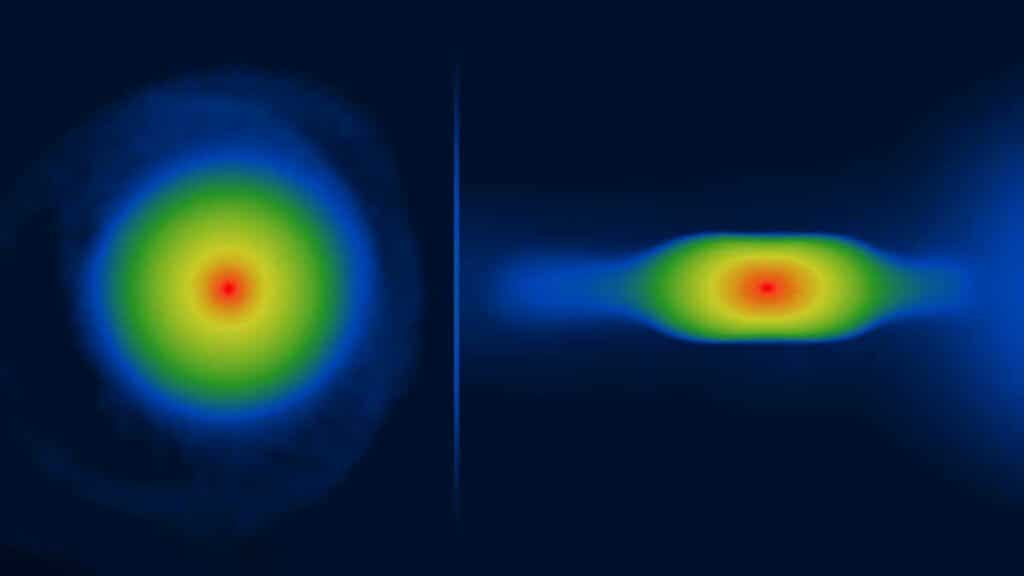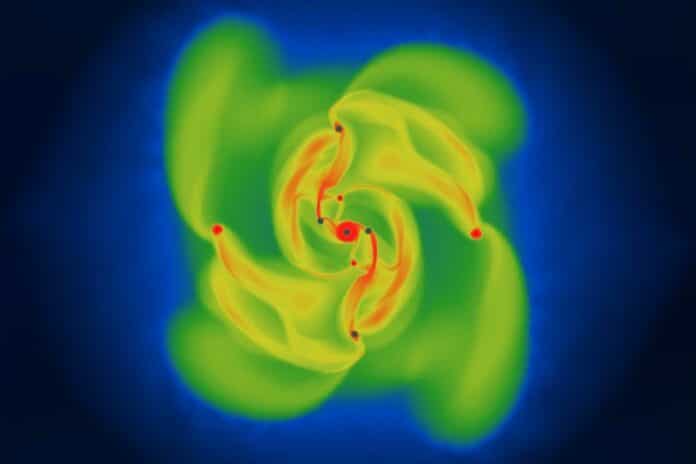The model of disc fragmentation due to gravitational instabilities offers an alternate formation mechanism for gas giant planets, especially those on wide orbits. In a new study, scientists aim to determine the 3D structure of disc-instability protoplanets and to examine how this relates to the thermal physics of the fragmentation process.
The team from UCLan‘s Jeremiah Horrocks Institute for Mathematics, Physics, and Astronomy employed computer simulations to model planet formation based on disc-instability theory. According to this theory, protoplanets emerge rapidly from the fragmentation of large rotating discs of dense gas encircling young stars.
Using this methodology, the team analyzed planet characteristics, cross-referenced them with observations, and scrutinized the formation process of gas giant planets. Their investigation focused on studying young planets’ shapes and how they could evolve into massive gas giants, potentially surpassing Jupiter in size. Additionally, they explored the properties of planets forming under diverse physical conditions, including variations in ambient temperature and gas density.
Research by astrophysicists from the University of Central Lancashire (UCLan) reveals that young planets exhibit flattened shapes akin to smarties rather than being perfectly spherical, as previously assumed.
The study indicates that protoplanets, newly formed planets orbiting stars, initially take on flattened structures known as oblate spheroids.

Using computer simulations based on the theory of disc-instability, the team from UCLan’s Jeremiah Horrocks Institute for Mathematics, Physics, and Astronomy modeled the formation of planets. According to this theory, protoplanets emerge rapidly from the fragmentation of large rotating discs of dense gas surrounding young stars.
Dr Adam Fenton, a recently graduated PhD student, led the research.
He said: “Many exoplanets, which are planets that orbit stars in other solar systems outside of our own, have been discovered in the last three decades. Despite observing many thousands of them, how they form remains unexplained.”
“It is believed that they either form through “core accretion,” which is a gradual growth of dust particles that stick together to form progressively larger and larger objects on long timescales, or directly by the breaking up of large rotating protostellar discs around young stars in short timescales, which is what we call the theory of disc-instability.”
“This theory is appealing because large planets can form very quickly at large distances from their host star, explaining some exoplanet observations.”
“It was an extremely demanding computational project requiring half a million CPU hours on the UK’s DiRAC High-Performance Computing Facility. But the results were amazing and worth the effort!”
Dr Dimitris Stamatellos, Reader in Astrophysics at UCLan and co-investigator, said: “We have been studying planet formation for a long time, but never before had we thought to check the shape of the planets as they form in the simulations. We had always assumed that they were spherical.”
“We were very surprised that they turned out to be oblate spheroids, pretty similar to smarties!”
Confirmation of the flattened shape of young planets suggests a shift in our understanding of planet formation, favoring the disc-instability model over the traditional core accretion theory.
Additionally, researchers found that new planets primarily grow as material falls onto them from their poles rather than their equators.
These findings imply that the appearance of planets observed through telescopes may vary depending on the viewing angle, highlighting the importance of observations of young planets in comprehending their formation mechanism.
Further studies will explore how the environment influences planet shape and determine their chemical composition, aligning with future observations from telescopes like the James Webb Space Telescope (JWST).
Recent advancements in observing facilities such as the Atacama Large Millimetre Array (ALMA) and the Very Large Telescope (VLT) have made observations of young planets possible in recent years.
Journal Reference:
- Adam Fenton and Dimitris Stamatellos. The 3D structure of disc-instability protoplanets. Astronomy & Astrophysics. DOI: 10.1051/0004-6361/202348753
